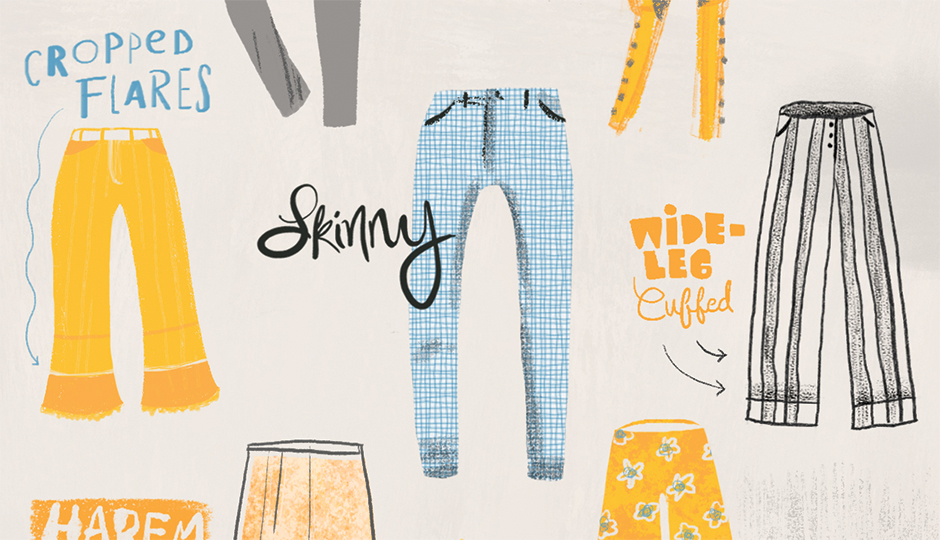Skinny Jeans, Just Die Already

Illustration by Laura Weiszer
When I was in college, nights out were a sea of black pants. There were slight variations, sure, but the gist was always the same: low-waisted, tight, boot-cut, made of stretchy synthetic fabric. We wore them with black boots and slinky, stringy Go-Out tops. (It was 2001. We knew no better.) Sometimes we even paired them with modest button-downs for our internships! We wore these pants while we smoked cigarettes and guzzled wine from a box, and we fancied ourselves very sexy and sophisticated.
Then came 2007, the dawn of a new era: the skinny jean, second-skin denim that shrink-wrapped the calves, strangled the ankles, and catapulted our black pants into obscurity. College girls now bought these instead; hell, we all bought them, in every color and wash imaginable. The churning wheel of corporate fashion chalked up a win. It had introduced us, the trend-
hungry public, to a fresh silhouette (boot-cut denim had reigned since the ’90s), and we devoured it. But then, a problem: We never stopped wearing them. By the late aughts, skinny jeans had become a staple. This was great for shoppers: We no longer needed to buy new pants every season. But the fashion industry thrives on newness — as do our local retailers, who need to sell new things to be successful — and our ongoing love affair with skinny jeans has become a big fat problem.
“So much of my business has been top-based in the past few years,” says Ann Gitter, co-owner of Knit Wit, a boutique with locations in Rittenhouse, Margate and Bryn Mawr. “It’s been the same pants, over and over.” Many other local shop owners are now feeling the pinch, too, as are national brands like J.Crew, Gap, and Philly-based Urban Outfitters. (In a Washington Post article earlier this year, Urban CEO Richard Hayne pointed to a lack of “fashion newness” when discussing the company’s lackluster 2015 sales.) Shop Sixty Five owner Linda LaRosa had an entire wall devoted to denim in her former Doylestown location. Now located just off the Square, she’s narrowed her pants offerings to the perennial sell-outs: ankle-length skinnies by Rag & Bone, J Brand, Elizabeth & James. The hems have changed — recently they’ve been frayed, let out, fringed — but the shape is the same.
There’s also this, though: Now, LaRosa can’t keep a pair of Helmut Lang palazzo pants in stock. Are the tides finally turning?
It wouldn’t be surprising. According to forecasters, bottom trends generally take about 10 years to shift, an evolution that feels molasses-slow compared to the typically breakneck pace of fashion. I blame this on the fact that shopping for pants is universally despised. Once you’ve found a style that’s flattering, why budge? But you just might have to: By the experts’ timetable, the era of skinny jeans ends in just six months.
“We’re on the brink of a big-time movement,” says Gitter. “If you can get away with wearing last year’s pants, that’s not good for me [as a retailer]. But now, I think change is on the horizon: pleated trousers, cropped pants with flares on them, a pant with a skirt attached. It’s going to help us.”
To say that pants are staging a comeback is, I know, an immeasurably obvious statement to make, sort of like declaring that sandals are trending for summer or that underpants are having a moment. But this fall, you’ll see fresh versions in stores: proper trousers, pleated palazzos, masculine pin-striped wide-legs, tweedy culottes. Embrace them.
For those wary of ditching the skinnies, consider the new pair that local designer Bela Shehu is debuting this month. Called the “Komo,” it’s a skinny black pant with a flare at the ankle that can be detached with invisible snaps. I’ve already pre-ordered a pair. And for those who can’t imagine wearing anything other than skinny jeans, take solace in this: You have 10 years to adjust.
Published as “R.I.P., Skinny Jeans” in the July issue of Philadelphia magazine.
